
Economics_-_New_Ways_of_Thinking
.pdf
Chapter Summary
Be sure you know and remember the following key points from the chapter sections.
Section 1
A business is an organization that uses resources to produce goods and services to sell to customers.
A business needs a boss to efficiently coordinate and direct the activities of others in the organization.
A sole proprietorship is a business owned by one person who makes the decisions, receives the profits earned, and is liable for the debts of the business.
A partnership is a business owned by two or more partners who share in the profits and are responsible for any liabilities of the business.
A corporation is a legal entity formed to conduct business and is owned by individuals who buy shares of the organization.
Section 2
Fixed costs are expenses that are the same no matter how many units of a good are produced.
Variable costs are expenses that vary according to the number of units produced.
Total costs Fixed costs Variable costs
Marginal cost is the additional cost of producing an additional unit of a good.
Section 3
Firms must answer two essential questions: How much should we produce? and What price should we charge?
Marginal revenue is the change in total revenue that results from selling an additional unit of output.
A firm’s goal is to maximize profit, which means producing a quantity of output at which marginal revenue equals marginal cost.
Economics Vocabulary
To reinforce your knowledge of the key terms in this chapter, fill in the following blanks on a separate piece of paper with the appropriate word or phrase.
1.In a sole proprietorship and partnership, owners have ______ liability, whereas in a corporation, owners have ______ liability.
2.The stockholders of the firm choose the
______.
3.Total cost equals ______ plus variable cost.
4.The additional cost of producing an additional unit of a good is called ______.
5.The ______ states that if additional units of a resource are added to a resource that is fixed in supply, eventually the additional output produced will decrease.
6.Another term for average total cost is ______.
7.The entity that offers a franchise is called the
______.
8.Ten percent of the face value of a bond is paid out regularly, so 10 percent is the ______ of the bond.
9.A(n) ______ for a firm is anything to which the firm has a legal claim.
10.The tax that a person pays on his or her income is called the ______ tax.
Understanding the Main Ideas
Write answers to the following questions to review the main ideas in this chapter.
1.List and explain two major differences between a corporation and a partnership.
2.To what taxes are we referring when we say that corporations are taxed twice?
3.Suppose a bond has a $10,000 face value and a coupon rate of 8 percent. What is the dollar amount of each annual coupon payment?
4.Specify the condition under which a firm will be formed.
5.In setting 1, Mayang works for herself. She gets to keep or sell everything she produces. In setting 2, Mayang works with five individuals.
Here, she gets to keep one-fifth of everything she produces and of everything that everyone
184 Chapter 7 Business Operations
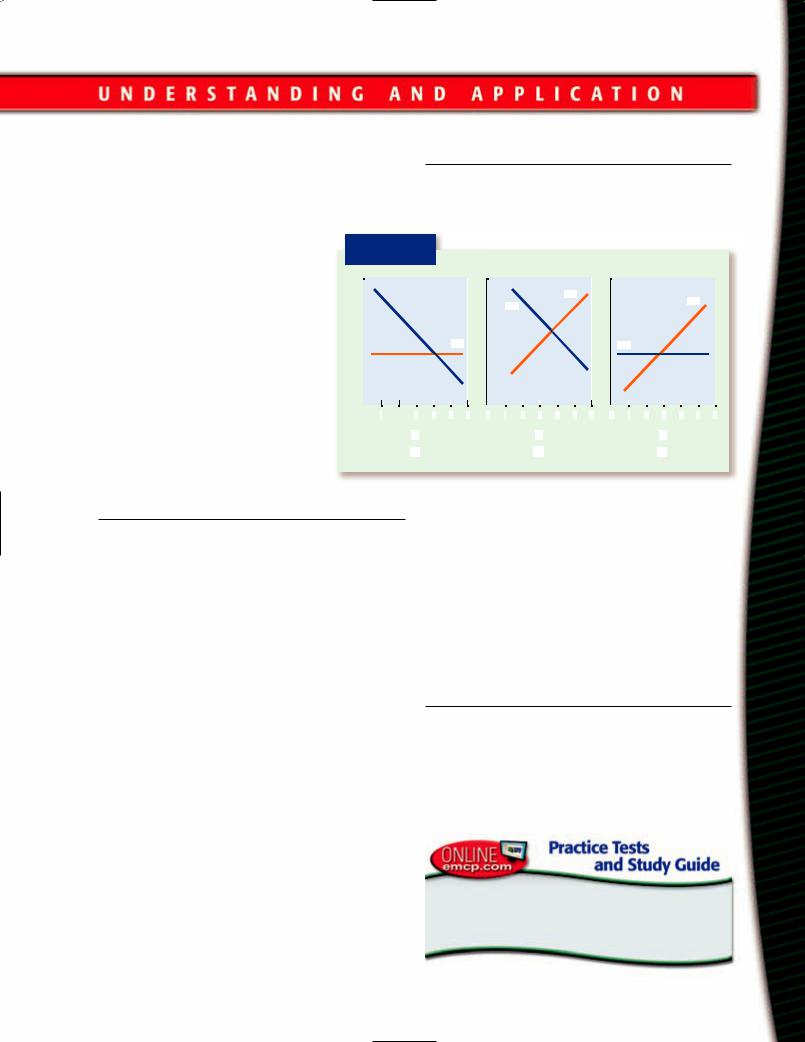
else produces. In which setting is Mayang more likely to shirk? Explain your answer.
6.What is the relationship between a bondholder and the firm that issued the bond? What is the
relationship between a stockholder and the firm that issued the stock?
7. In general, what is the difference between fixed and variable costs?
8.Explain why a firm continues to produce those units of a good for which marginal revenue is
greater than marginal cost. |
$ |
|
9.A firm will produce and sell units of a good if marginal revenue is greater than marginal
cost. Does this strategy have any-
thing to do with the firm’s objec- 0  2 tive to maximize profit? Explain.
2 tive to maximize profit? Explain.
10.How does a firm compute its profit or loss?
Doing the Math
Do the calculations necessary to solve the following problems.
1.Calculate the marginal cost for the additional unit in each of the following cases. (TC total cost, and Q = quantity of output.)
a.Q 100, TC $4,322; Q 101, TC $4,376
b.Q 210, TC $5,687; Q 211, TC $5,699
c.Q 547, TC $10,009; Q 548, TC $10,123
2.Calculate the average total cost in each of the following cases. (TC total cost, and Q quantity of output.)
a.Q 120, TC $3,400
b.Q 200, TC $4,560
c.Q 150, TC $1,500
3.The marginal benefit of playing chess (in money terms) is $10 for the first game of chess, $8 for the second, $6 for the third, $4 for the fourth, $2 for the fifth, and $0 for the sixth. The marginal cost of playing chess (in money terms) is always $5. What is the right number of games of chess to play? Explain your answer.
4.Look at Exhibit 7-6. Suppose it costs a firm $45
aday to hire the fifth worker. What does the price of the good the firm produces have to be before it is worth hiring the fifth worker?
Working with Graphs
In Exhibit 7-8, Q quantity of the good, MC marginal cost, and MR marginal revenue. Which part or parts (a–c) illustrate the following?
7-8
|
|
|
|
|
|
|
|
|
|
|
|
|
|
|
|
|
|
|
|
|
|
|
|
|
|
|
|
|
|
|
|
|
|
|
|
|
|
|
|
|
|
|
|
|
|
|
|
|
|
|
|
|
|
|
|
|
|
|
|
|
|
|
|
|
|
|
|
|
|
|
|
|
|
|
|
|
|
|
|
|
|
|
|
|
|
|
|
|
|
|
|
|
|
|
|
|
|
|
|
|
|
|
|
|
|
|
|
|
|
|
|
|
|
|
|
|
|
|
|
|
|
|
|
|
|
|
|
|
|
|
|
|
|
|
|
|
|
|
|
|
|
|
|
|
|
|
|
|
|
|
|
|
|
|
|
|
|
|
|
|
|
|
|
|
|
|
|
|
|
|
|
|
|
|
|
|
|
|
|
|
|
|
|
|
|
|
|
|
|
|
|
|
|
|
|
|
|
|
|
|
|
|
|
|
|
|
|
|
|
|
|
|
|
|
|
|
|
|
|
|
|
|
|
|
|
|
|
|
|
|
|
|
|
|
|
|
|
|
|
|
|
|
|
|
|
|
|
|
|
|
|
|
|
|
|
|
|
|
|
|
|
|
|
|
|
|
|
|
|
|
|
|
|
|
|
|
|
|
|
|
|
|
|
|
|
|
|
|
|
|
|
|
|
|
|
|
|
|
|
|
|
|
|
|
|
|
|
|
|
|
|
|
|
|
|
|
|
|
|
|
|
|
|
|
|
|
|
|
|
|
|
|
|
|
|
|
|
|
|
|
|
|
|
|
|
|
|
|
|
|
|
|
|
|
|
|
|
|
|
|
|
|
|
|
|
|
|
|
|
|
|
|
|
|
|
|
|
|
|
|
|
|
|
|
|
|
|
|
|
|
|
|
|
|
|
|
|
|
|
|
|
|
|
|
|
|
|
|
|
|
||
|
6 |
|
|
|
|
6 |
|
|
6 |
|||||||||||||||||||||||||||||||||||||||||||||||||
|
0 |
2 |
0 |
2 |
||||||||||||||||||||||||||||||||||||||||||||||||||||||
3 |
|
4 |
5 |
|
3 |
|
|
4 |
5 |
|
|
|
3 |
|
|
4 |
5 |
|
|
|||||||||||||||||||||||||||||||||||||||
|
|
|
|
|
|
|
|
|
|
|
|
|
|
|
|
|
|
|
|
|
|
|
|
|
|
|
|
|
|
|
|
|
|
|
|
|
|
|
|
|
|
|
|
|
|
|
|
|
|
|
|
|
|
|
|
|
|
|
Q |
|
|
|
|
|
|
|
|
|
|
|
|
|
|
Q |
|
|
|
|
|
|
|
|
|
|
|
|
|
|
|
Q |
|
|
|
|
|
|
|
|
|
|
|||||||||||||||||
|
|
|
|
|
|
|
|
|
|
|
|
|
|
|
|
|
|
|
|
|
|
|
|
|
|
|
|
|
|
|
|
|
|
|
|
|
|
|
|
|
|
|
|
|
|
|
|
|
|
|
|
|||||||
|
|
|
|
|
|
|
|
|
|
|
|
|
|
|
|
|
|
|
|
(b) |
|
|
|
|
|
|
|
|
|
|
|
|
|
|
|
|
|
|
|
|
|
|
|
|
|
|||||||||||||
(a) |
|
|
|
|
|
|
|
|
|
|
|
|
|
|
|
|
|
|
|
|
|
|
|
|
|
|
|
|
|
(c) |
|
|
|
|
|
|
|
|
|
|
||||||||||||||||||
1.Jim pays more to produce the second unit of the good than the first, more for the third than the second, and so on.
2.The additional “benefits” of producing the fourth unit of the good are the same as the additional benefits of producing the fifth.
3.Marginal revenue is constant over a specific quantity of the good produced.
4.Marginal revenue declines as the firm sells additional units of the good.
Solving Economic Problems
1.Application. When Dairy Queen first began, it did not require franchisees to handle all Dairy Queen products. In contrast, McDonald’s requires its franchisees to handle all of its products. If you were a franchiser, what kind of agreement would you want, and why?
Go to www.emcp.net/economics and choose Economics: New Ways of Thinking, Chapter 7, if you need more help in preparing for the chapter test.
Chapter 7 Business Operations 185
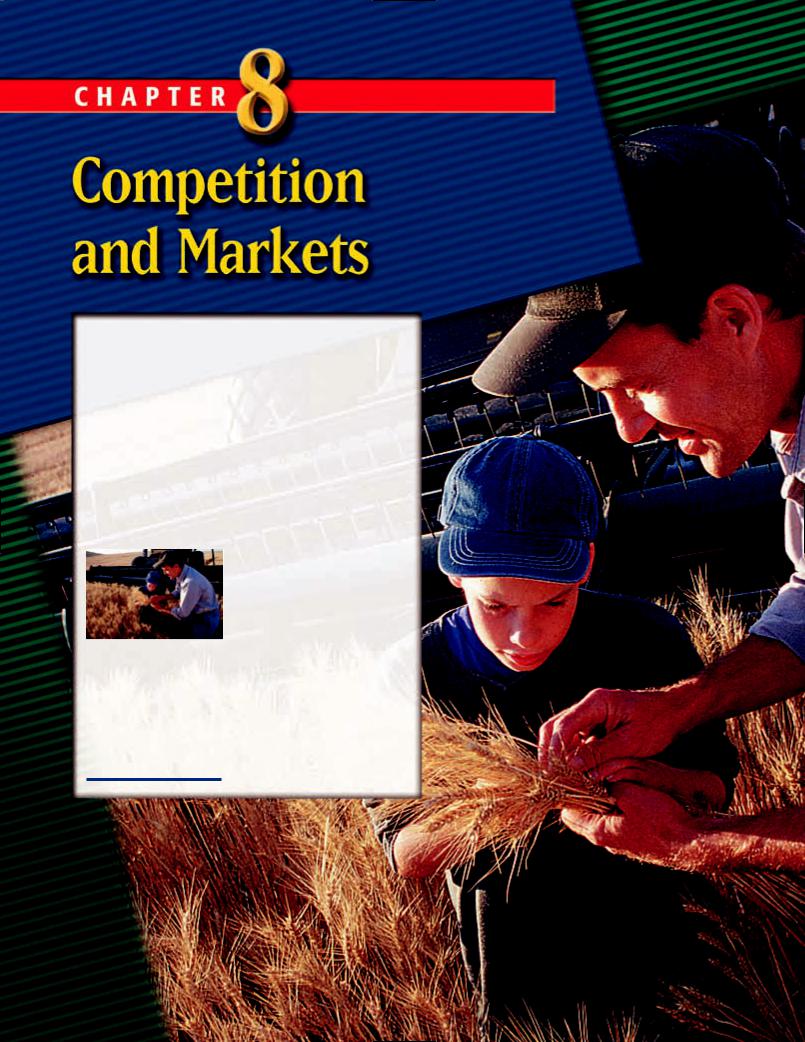
Why It Matters
Sometimes you can negotiate the price you pay for a good. You are about to buy a car, for example. The sticker price is $25,000.
You offer the car dealer $23,000. He comes back with $24,500. You say $24,200 and the dealer accepts your offer.
Sometimes you can’t negotiate the price you pay. You want to buy a shirt at a store in the mall. The price is $30. You don’t say to the clothing salesperson, “I’ll pay $25 for the shirt.” Instead,
you pay $30.
The lesson here is that not all goods are sold in the identical type of market. In some markets, you negotiate price; in others, you don’t. Some markets are competitive; others are not. Knowledge of the material in this chapter will help you better understand why markets function in different ways.
186
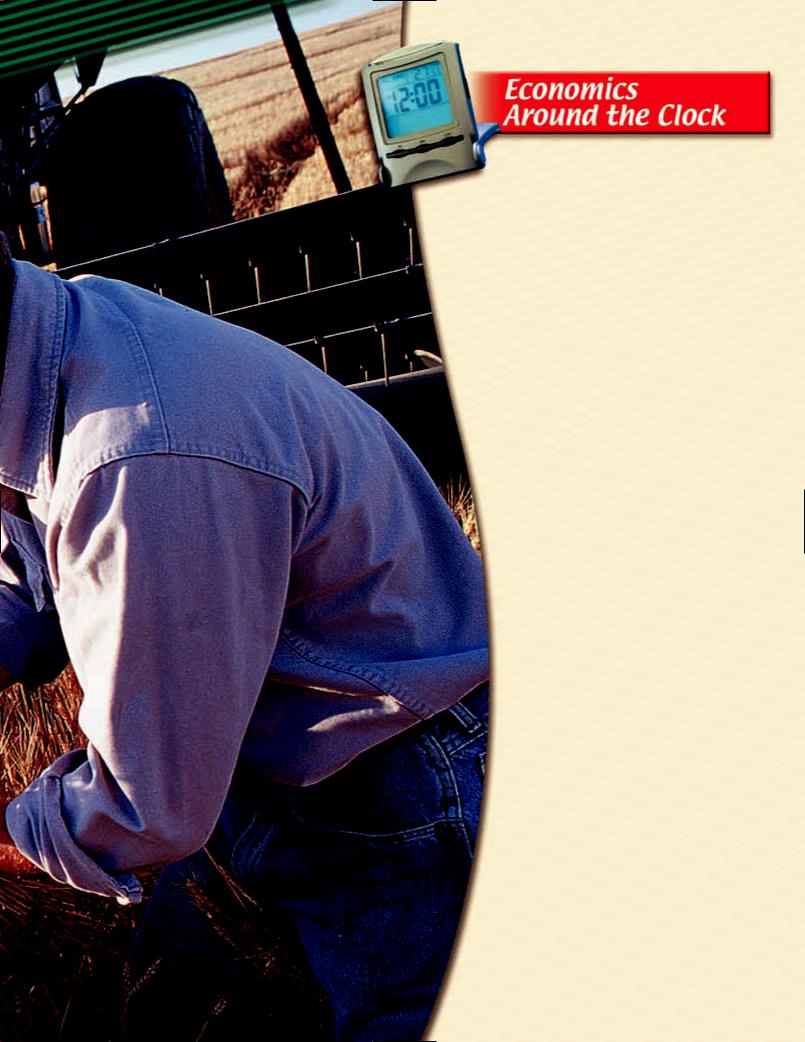
The following events occurred one day in July.
9:22 A.M. Barry walks around the car lot looking at new cars. A car salesperson approaches him and asks if he can be of any help. “I’m just looking around,” Barry says. “Did you have any
specific model in mind?” the car salesperson asks. “Not really,” Barry says. The car salesperson walks and talks with Barry as he looks at the different cars on the lot. At one point, the car sales-
person nonchalantly asks Barry what he does for a living.
• Why did the car salesperson ask Barry what he does for a living?
10:04 A.M. Melissa loves to read. She is currently in her local bookstore looking at the newest fiction. Melissa reads the first few pages of a book by one of her favorite authors. She then closes the book and checks the price— $29.99. She wonders whether she should buy it. On the
one hand, she really wants the book. On the other hand, it’s expensive and she knows that she could wait until the book comes out in paperback. It would be much
more affordable then.
• Why do book publishers publish the exact same book in hardcover and in paperback, but come out with the hardcover edition months before the paperback edition?
7:34 P.M. Ethan is at Petco Park in San Diego watching the San Diego Padres play the Milwaukee Brewers. He is thinking about going to the concession stand and buying a hamburger, some peanuts, and a soft drink. The price of the hamburger is $6.50, a bag of peanuts is $5.00, and a soft drink is $3.75. The total price for the three items is $15.25. “That is a lot of money,” Ethan thinks to himself. “I don’t know why food is so expensive at a baseball game.”
• Why is food so expensive at a baseball park?
9:59 P.M. George is getting ready to take his medicine. He heard a news report on television earlier this evening saying that the company that produces his medicine actually sells the medicine for much less in foreign countries than it does in the United States. He pays $95 for a month’s supply, but understands that if he lived in India he could buy the same medicine for the equivalent of $30.
• Why does George, in the United States, pay more for the same medicine that a person in India buys for much less?
187
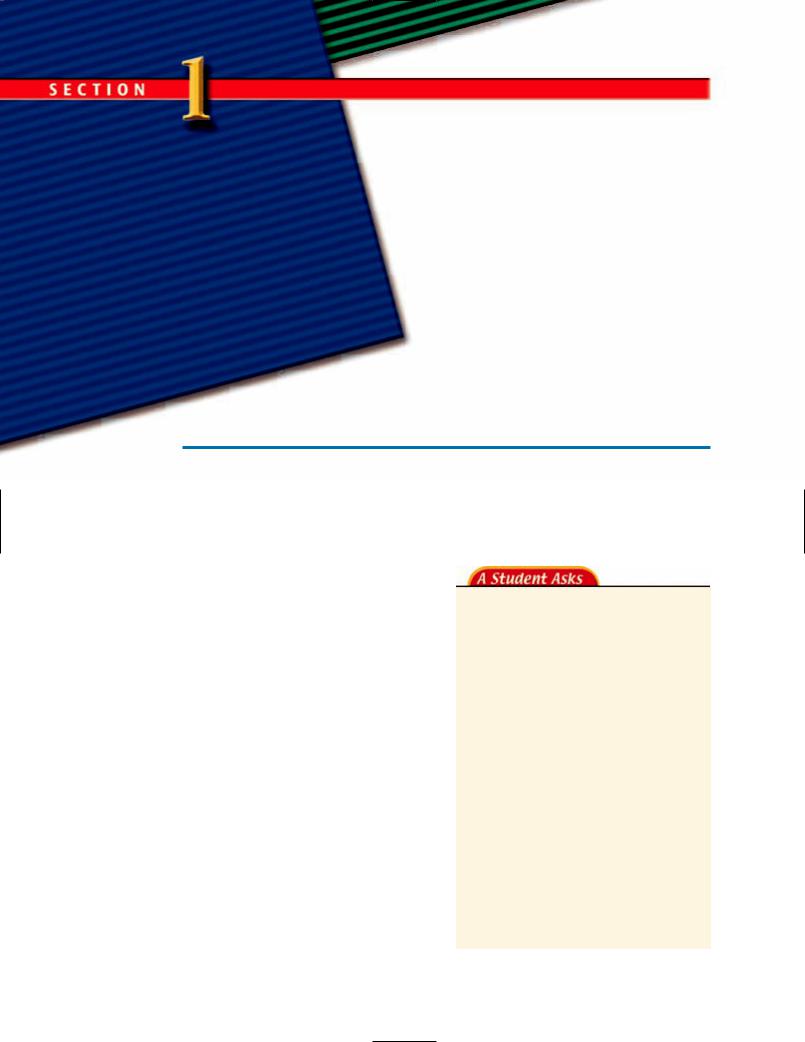
A Perfectly
Competitive
Market
Focus Questions
What are the characteristics of a perfectly competitive market?
What are some examples of perfectly competitive markets?
What does it mean to say that a firm has no control over price?
What role does profit play in a perfectly competitive market?
Key Terms
market structure
perfectly competitive market price taker
market structure
The setting in which a seller finds itself. Market structures are defined by their characteristics, such as the number of sellers in the market, the product that sellers produce and sell, and how easy or difficult it is for new firms to enter the market.
Four Types of Markets
The more than 25 million businesses in the United States include car companies, bookstores, clothing stores, grocery stores, hair salons, restaurants, and more. Not every one of the 25 million businesses operates in the same kind of market.
Economists talk about the different types of market structures. Market structures are defined by their characteristics, such as the number of sellers in the market, the product that sellers produce and sell, and how easy or difficult it is for new firms to enter the market. You will learn about four types of markets —perfectly competitive, monopolistic, monopolistic competitive, and oligopolistic —in this chapter.
For now, think of each of the four kinds of markets the way you might think of four different rooms in a house. Each room is similar to and different from every other room. All rooms have floors and ceilings, but not all rooms are painted the same color, or are the same size.
It’s the same with markets. They have some things in common (they all have buy-
ers and sellers), and a few things that differ. Let’s begin by discussing our first market, the perfectly competitive market.
QUESTION: For me, as a buyer, almost all markets seem the same. For example, I can’t tell much difference between the market for books and the market for skateboards. In both markets, if I want to buy something, I pay the price that is charged. What are economists looking at to distinguish one market from another?
ANSWER: What you implied about markets—they all seem the same—can be said about other things too. Someone might say that he can’t tell much difference between two shirts. But, on a closer look, one shirt might be cotton and the other flannel, or one might be a shortsleeve shirt and the other a long-sleeve shirt. It is the same with markets: the closer you look at them, the more differences you can find. Economists look
188 Chapter 8 Competition and Markets

at a variety of things to distinguish between markets, such as how many sellers there are in a market (many, a few, only one), how many buyers in a market, and whether sellers sell the same good or a slightly differentiated good. You will see more of the differences as you progress through this chapter.
Characteristics of a Perfectly
Competitive Market
Economists categorize markets according to their characteristics. Here are four characteristics of a perfectly competitive market.
1.The market has many buyers and many sellers.
2.All firms sell identical goods.
3.Buyers and sellers have relevant information about prices, product quality, sources of supply, and so on.
4.Firms have easy entry into and exit out of the market.
 Jones is a wheat farmer, or a producer and seller of wheat. Does Jones sell his wheat in a perfectly competitive market? In other words, is the wheat market a “perfectly competitive market”? To answer this question we have to determine whether the wheat market has the four characteristics that any perfectly competitive market has. First, does it have many buyers and many sellers of wheat? The answer is yes; so the first characteristic holds for the wheat market. Second, do all wheat sellers sell the same wheat? For a given type of wheat, the answer is yes. It would be impossible, for example, to tell Jones’s wheat from any other farmer’s wheat. So, the second characteristic of a perfectly competitive market holds. Third, do buyers and sellers of wheat possess information on the quality of wheat, prices of wheat, and so on. The answer is yes. For example, wheat farmers often get up in the morning and check the daily wheat report. They know what price wheat is selling for on that given day. So, the third characteristic of a perfectly competi-
Jones is a wheat farmer, or a producer and seller of wheat. Does Jones sell his wheat in a perfectly competitive market? In other words, is the wheat market a “perfectly competitive market”? To answer this question we have to determine whether the wheat market has the four characteristics that any perfectly competitive market has. First, does it have many buyers and many sellers of wheat? The answer is yes; so the first characteristic holds for the wheat market. Second, do all wheat sellers sell the same wheat? For a given type of wheat, the answer is yes. It would be impossible, for example, to tell Jones’s wheat from any other farmer’s wheat. So, the second characteristic of a perfectly competitive market holds. Third, do buyers and sellers of wheat possess information on the quality of wheat, prices of wheat, and so on. The answer is yes. For example, wheat farmers often get up in the morning and check the daily wheat report. They know what price wheat is selling for on that given day. So, the third characteristic of a perfectly competi-
Many different kinds of stores sell many different products in a typical modern mall. Do you think any of the markets represented by these stores and products are perfectly competitive markets? If so, what four characteristics must be present?
tive market holds. Fourth, is entry into and out of the wheat market easy? In other words, is it easy for Jones to leave the farming business if he wants to, and would it be easy for others (if they wanted to) to get into the farming business. The answer is yes. Nothing prevents Jones from deciding to no longer be a farmer and nothing prevents you or anyone else from being a wheat farmer. If an accountant at an accounting firm wants to quit his job tomorrow, buy some land in Kansas, and start wheat farming, she is free to do just that. You might say it is expensive to get into farming, so doesn’t that make it hard to get into farming? It may be expensive, but what economists mean when they say that there is “easy entry and exit” is that no entity prevents the entry into or exit from a market. For example, government doesn’t prevent individuals from going into farming if they want. So, the fourth characteristic of a perfectly competitive market is met. We can conclude then the wheat market is a perfectly competitive market.
perfectly competitive market
A market structure characterized by (1) many buyers and many sellers,
(2) all firms selling identical goods, (3) all relevant information about buying and selling activities available to buyers and sellers, and (4) easy entry into and easy exit out of the market.
Section 1 A Perfectly Competitive Market 189
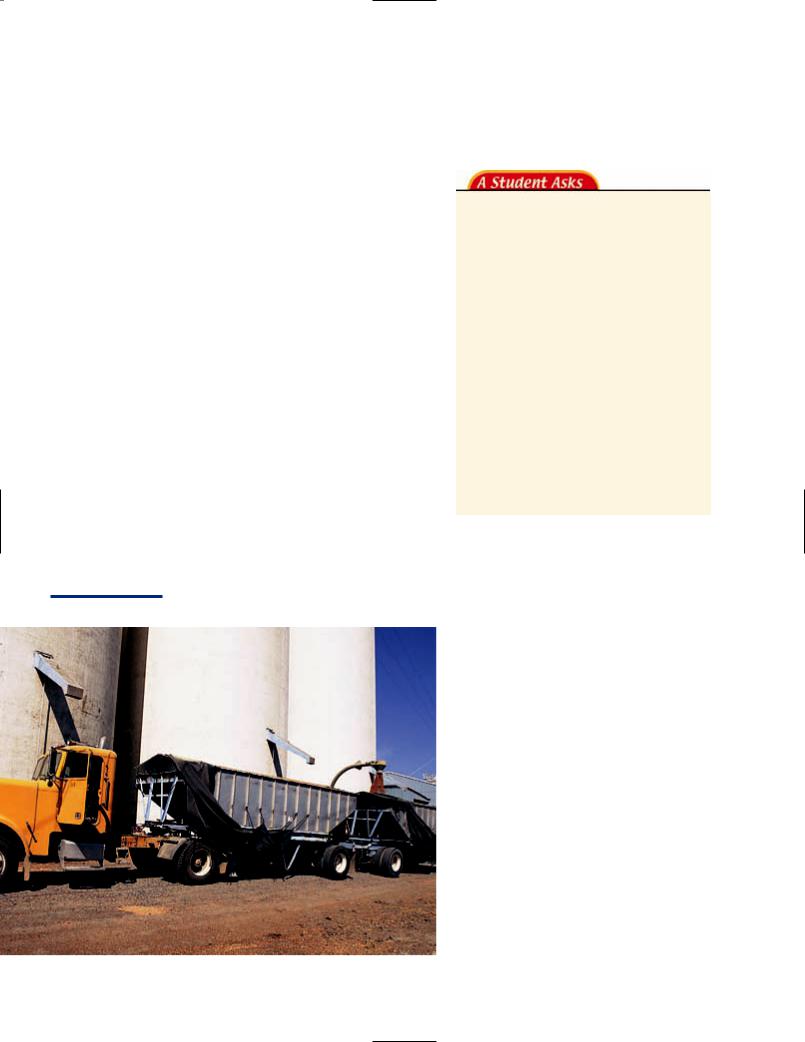
price taker
A seller that can sell all its output at the equilibrium price but can sell none of its output at any other price.
Sellers of commodities such as corn and wheat are price takers. Can you explain why?
Sellers in a Perfectly
Competitive Market Are
Price Takers
Because of the four characteristics of a perfectly competitive market, sellers in this market end up being price takers. It is similar to saying that a person who exercises daily, eats healthfully, and always gets enough sleep will end up being healthier than if the person didn’t do these things. Certain things follow from certain characteristics. When it comes to the perfectly competitive market, its characteristics determine that a seller in this market will be a price taker. A price taker is a seller that can only sell his or her goods at the equilibrium price (think back to Chapter 6 where we explained how the equilibrium price came to exist). In other words, suppose Jones, the farmer, is a price taker. What does this mean for him? It means that he gets up in the morning, turns on the radio or television, and finds out what today’s equilibrium price for wheat is. If it is, say, $5 a bushel, Jones will have to sell his wheat at this price and no other price.
Now consider another price taker, this time in a market other than the wheat market. Consider Brown, who owns 1,000 shares of Disney stock. One day Brown decides to sell her stock (just like Jones might have
decided to sell his wheat). Brown goes online and checks the current (equilibrium) price of Disney stock. If it is $27.80, then this is the price Brown must “take” if she wants to sell her stock. She won’t be able to sell her stock for even one penny more.
QUESTION: Aren’t all sellers price takers? Don’t all sellers have to sell their goods at the equilibrium price determined by supply and demand?
ANSWER: No. Think of the difference between the seller of stock or wheat and the seller of, say, books. The stock seller can only sell her stock at one price—the equilibrium price. Charge one penny higher, and she can’t sell any stock. The wheat seller can only sell his wheat at one price—the equilibrium price. Charge one penny higher, and he can’t sell any wheat. But the seller of books can sell books at various prices, although the bookseller can’t sell as many books at a higher price as at a lower price.
Can Price Takers Sell for Less than the Equilibrium Price?
So we learned that if Jones, the farmer, and Brown, the stock seller, want to sell what they own (wheat and stock) they will have to sell at the equilibrium price in their respective markets, and not at one penny more. What happens if they want to sell for one penny less? If the equilibrium price of Disney stock is $27.80, can’t Brown sell her stock at $27.50 (for 30 cents less)? Yes, she can. No buyer is going to turn down a lower price. The point is that Brown has no reason to offer to sell her stock at a price lower than the equilibrium price. After all, she can sell all her stock at the equilibrium price of $27.80. So, two points are true for every price taker:
1.He or she cannot sell for a price higher than equilibrium price.
2.He or she will not sell for a price lower than equilibrium price.
190 Chapter 8 Competition and Markets

Patty owns 10 ounces of gold that she wants to sell. She checks the daily (equilibrium) price for gold on a particular day; it is $418. She will have to sell her gold for $418 an ounce. If, by chance, she charges a higher price—say, $420—she won’t sell even an ounce of gold at that price. Patty is a price taker.
Must a Perfectly
Competitive Market Possess
All Four Characteristics?
Recall that a perfectly competitive market has four characteristics. Is a real-world market still a perfectly competitive market if it doesn’t perfectly match these four characteristics? For example, suppose a market has characteristics 1, 2, and 4 (you may want to look back to refresh your memory on the four characteristics of a perfectly competitive market), but only slightly satisfies characteristic 3. Does it follow that because this market doesn’t satisfy all four characteristics 100 percent that it isn’t a perfectly competitive market? The answer is no.
Think about this old saying: If it looks like a duck and quacks like a duck, it is probably a duck. The same thing holds for markets too. If a seller is a price taker—that is, if he or she can only sell at the equilibrium price—then for all practical purposes this seller is operating in a perfectly competitive market. Rephrasing the duck saying, we get: If a seller is a price taker, then it is operating in a perfectly competitive market.
What Does a Perfectly
Competitive Firm Do?
As we said in the previous chapter, every firm has to answer certain questions. Two questions we identified are:
1.How much of our product do we produce?
2.What price do we charge for our product?
How does a perfectly competitive firm answer the first question of how much to produce? It answers it the way any firm
would answer it. It produces the quantity of output at which marginal revenue (MR) equals marginal cost (MC).
How does the perfectly competitive firm answer the second question of what price to charge? Because it is a price taker, it has no choice in the matter: It sells its product for the equilibrium price determined in the market. If the equilibrium price is $10, then that is the price it charges, not $10.01 or $9.99.
So, to summarize answers to the two questions: (1) perfectly competitive firms produce the quantity of output at which marginal revenue equals marginal cost;
(2) they charge the equilibrium price for their product.
 Market A is a perfectly competitive market. Currently, the equilibrium price is $10. The total revenue and marginal revenue data for one seller in this market look like the following:
Market A is a perfectly competitive market. Currently, the equilibrium price is $10. The total revenue and marginal revenue data for one seller in this market look like the following:
Units of |
Total |
Marginal |
output |
revenue |
revenue |
|
|
|
1 |
$10 |
$10 |
2 |
20 |
10 |
3 |
30 |
10 |
|
|
|
This firm’s total cost and marginal cost data look like the following:
Units of |
Total |
Marginal |
output |
cost |
cost |
|
|
|
1 |
$ 6 |
$ 6 |
2 |
14 |
8 |
3 |
24 |
10 |
|
|
|
If this manufacturer operates in a perfectly competitive market, how does it decide what price to charge for its products?
Section 1 A Perfectly Competitive Market 191
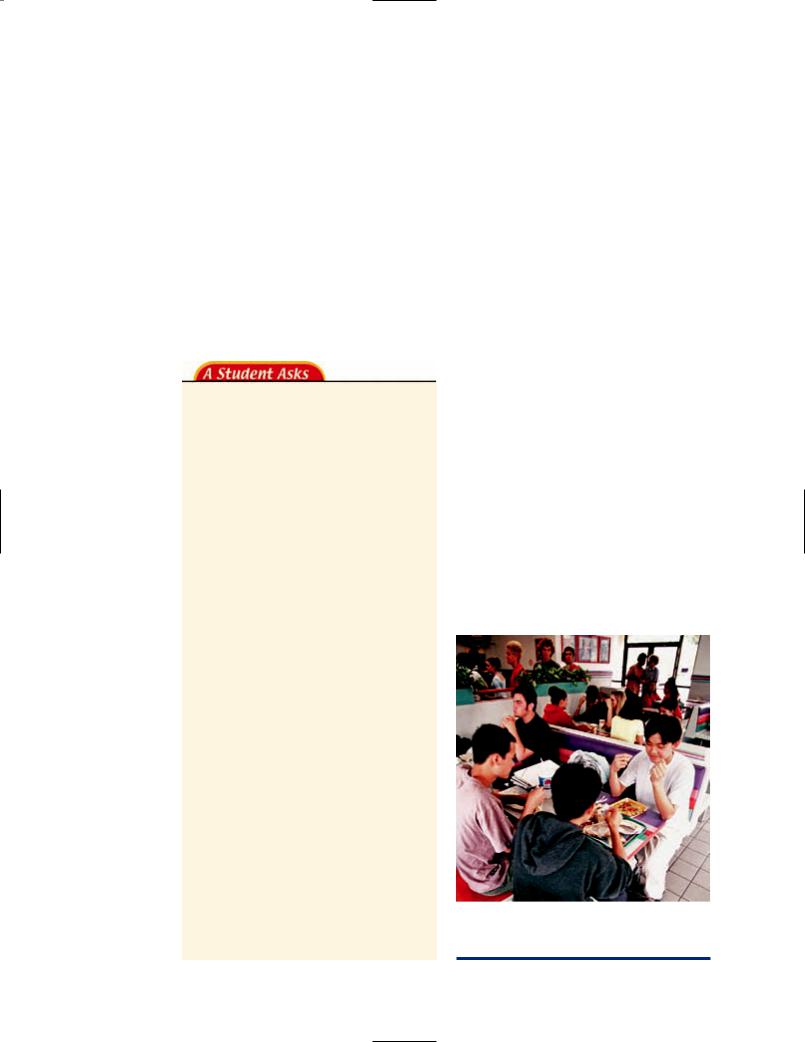
Now ask what quantity of output this firm will produce. You know that it wants to produce the quantity of output at which marginal revenue equals marginal cost: MR = MC occurs at a quantity of 3 units. Now ask what price it will charge for each of the 3 units it sells. Because the firm is a price taker, it takes the equilibrium price of $10. So, it produces 3 units and charges a price of $10 for each unit.
How much profit does this firm earn? We know that profit is the difference between total revenue and total cost. When the firm produces 3 units of output its total revenue is $30 and its total cost is $24, so it follows that this firm’s profit is $6.
QUESTION: How did you get the dollar amounts in the marginal revenue (MR) column and in the marginal cost (MC) column?
ANSWER: Remember from Chapter 7 that marginal revenue is the additional revenue from producing an additional unit of a good. Notice that when the firm sells 1 unit of the good its total revenue is $10 and when it sells 2 units of a good its total revenue is $20. What is the additional revenue generated due to selling the additional unit (the second unit)? Obviously the answer is $10. The same holds going from selling 2 units to 3 units. The total revenue for the firm when it sells 2 units is $20 and it is $30 when it sells 3 units; therefore the additional revenue due to selling the additional unit (the third unit) is $10. Here is the MR equation from Chapter 7:
Marginal revenue (MR) ∆TR/∆Q
As to the dollar amounts in the marginal cost (MC) column, we just made up these dollar amounts. Often, in the real world, marginal cost rises as a firm produces additional units of a good, so we had the marginal cost dollar amounts rise in our example.
Profit Is a Signal in a
Perfectly Competitive
Market
Suppose 200 sellers operate in market X, a perfectly competitive market. Each of the sellers produces good X and sells it for its current equilibrium price, $10. Furthermore, all 200 firms earn profits. Will things stay as they are currently? Not likely.
According to the fourth characteristic of a perfectly competitive market, easy entry is an aspect of a perfectly competitive market. In other words, firms that are currently not in market X can easily get into that market. Nothing is holding them out. As long as sellers are earning profits in that market, the answer is yes.
As new firms enter market X, the number of firms in the market increases, say from 200 to 250. With more firms, the supply of good X increases. (Remember from Chapter 5 that as the number of sellers increases, the supply of the good increases too—the supply curve shifts rightward.) When the supply of a good rises, equilibrium price falls. Furthermore, as price falls, so does profit. Profit, remember, is total revenue (price times number of units sold) minus total cost. In this case, as price falls, so do total revenue and profit.
How long will new firms keep entering market X? Until they see no reason to do
What is likely to happen if this fastfood restaurant’s profits begin to climb?
192 Chapter 8 Competition and Markets

so—that is, until the competition eliminates the profit. When profit falls to zero and total revenue exactly equals total cost, firms will no longer have a monetary incentive to enter market X.
In a perfectly competitive market, then, profit acts as a signal to firms that are currently not in the market. It says,“Come over here and get me.” As new firms gravitate toward the profit, they increase the supply of the good that is earning profit and thus lower its price. As they lower its price, the profit dissipates. The process ends when firms no longer see an incentive to enter the market to obtain profit:
Profit exists → New firms enter the market → Supply rises → Price falls →
Price falls until firms no longer see an incentive to enter the market
QUESTION: Can you give us some examples of profit (in a market) that signals other firms to enter into the the market, ultimately reducing the price that consumers pay?
ANSWER: Think about the prices you sometimes pay for new goods (goods that have just been introduced). When the VCR was introduced, its price was more than $1,000. The profit in the VCR market acted as a signal to new firms to enter that market. As they did, the supply of VCRs went up and the price of VCRs fell.
same thing happened in the market for calculators (the early ones with numerous functions sold for about $400), the market for personal computers, the market for DVD players, and many more markets.
Profits May Be Taxed Away
Suppose we go back to the point in time when the 200 firms in market X were all earning profits. Now suppose a member of Congress says, “The firms in market X are earning huge profits. They do not deserve them; they just happened to be in the right place at the right time. The government needs some additional money for some new programs, so we ought to tax these profits. I propose a special tax on these profits of 100 percent.”
Congress goes along with this member, enacts a special tax on the profits of the firms in market X, and taxes away these profits. With the profits taxed away, the reason for firms not currently in market X to enter it is gone. If no new firms enter market X, the supply of good X will not rise, and the price of good X will not then fall. This situation leaves consumers paying a higher price than they would have paid if the profits of the 200 firms had not been taxed away.
The intended effect was to tax away the profits of the 200 firms and to generate new revenue for the government. The unintended effect was that consumers ended up
Defining Terms
1.Define:
a.price taker
b.market structure
c.perfectly competitive market
Reviewing Facts and
Concepts
2.What is easy entry into a market and easy exit out of the market?
3. What quantity of output |
(a) exit out of the market, |
|
does a perfectly competi- |
(b) the supply of the good |
|
tive firm produce? What |
produced in the market, |
|
price does it charge for its |
and (c) the price of the |
|
product? |
good? Explain your |
|
Critical Thinking |
answers. |
|
Applying Economic |
||
4. Some of the 200 firms in |
||
market X, a perfectly |
Concepts |
|
competitive market, are |
5. How can a seller deter- |
|
incurring losses. How will |
mine whether it is a price |
|
these losses influence |
taker? |
Section 1 A Perfectly Competitive Market 193
